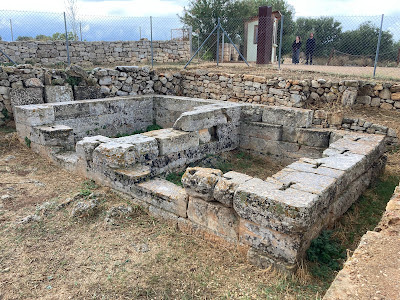With another humid, and rainy-day forecast – we put on our walking boots and set out from Vamos to explore the local area. Perusing the guidebook “Discover Vamos… on Foot” we decided to follow “Walk 5: To the villages of Gavalochori and Douliana”.
The easy walking route took us northeast out of Vamos, along small roads, and tracks between fields. We passed picturesque roadside chapels, and expensive looking holiday Villas. The views across the hilltops and valleys were unexpectedly lush, as they swept down towards Souda Bay.
 |
| looking north to Souda Bay |
Arriving at Gavalochori, we visited the Venetian olive mill. The vaulted building contains different examples of mills and olive presses including a metal press dating from the late 19th / early 20th century.
The
on-site interpretation has photos from the 1950s of these machines still in use. |
| Venetian period - four stone olive mill |
 |
| 19th Century metal olive press |
 |
| On site interpretation |
As we left the olive mill, I noticed a tourist sign pointing to the Gavalochori Wells 500m uphill. The guidebook does not mention these wells, so we followed the sign out of curiosity.
Rounding a bend in the road, the wells came into view. They were momentarily underwhelming, appearing to be square concrete topped cisterns, with a raised concrete cap topped by a metal hatch. As we got closer, we noted curious stone "caves" clustered towards the back of the site. A large twin stemmed Plane (Platanus orientalis) grows center stage.
 |
| Gavalochori Wells |
I lifted the rusted hatch of a cistern and looked down a small shaft with water at the bottom. Going across to a stone built “cave” I looked within, experienced a moment of vertigo, and pulled back from the opening.
Listening to my body, I realised that I was hungry and thirsty, that I had expended the last of my energy on the approach to the wells. A, sat on the wall beneath the Plane. I sat down next to A, and we broke bread together.
After our lunch, I explored the “caves” further – they are stone-built roofs over stone-lined well shafts. A number were dry at the bottom, whilst others held the reflection from the water within. I dropped a pebble into one and a deep "whoomph" echoed around me. Laughing, I repeated the action. Later I was to regret not committing the sound to the library of Voice Memos on my iPhone.
The stone-built wells are of the Venetian period as is the arched bridge which spans the dry creek running past the site. The modern metalled road bridge also crosses the creek.
 |
| Venetian Well |
Heading back into Gavalochori we passed inviting tavernas, knowing that we had only covered about a third of our walk, we declined to stop for a cold beer or two. Walking past the Folklore Museum, we agreed that this was also a destination for another day.
 |
| Gavalochori |
Our route out of Gavalochori, seemed to be endlessly uphill on the bearing to Douliana. With even the short sections of downhill providing no respite. And then we turned left at a junction onto a small track, slowly climbing up through a small, wooded, valley or gorge.
Cut out of the rockface of the gorge, is the small cave church of Agios Ioannis, set back behind a tall white wall, and gate. In the courtyard stands a decrepit anthropomorphic olive tree, headless, legs akimbo, joyful.
Shortly after leaving the church, we turned right at a T-junction and climb a steep cobbled path up the side of the valley – the recent rain making the path stones slick and slowing the ascent.
Arriving at Douliana, we pressed on through the village, and back out onto the open hillside – gleefully noting the accuracy of the books instructions when turning left at a fork where “there are three similar houses on your left.” The last section of the trek crossed enclosed farmland. We passed between enclosures by opening “gates” comprising sheep netting or thin wire meshes, tied with string. A soft rain followed, and we were more than happy to end up roadside just a short walk away from our hotel apartment.
ReferencesCretanbeaches.com [Online] 2022
Cretan Flora Plane Tree https://www.cretanbeaches.com/en/flora/plane-tree Accessed 28th November 2022
Accessed 27th November 2022
Yiapitsoglou,
K., (Editor) 2008 The Olive Tree Civilization in Crete; Olive Oil Production
on the Post Byzantine Times; Oil Mill of Gavalochori Association of Cretan
Oil Municipalities





















































